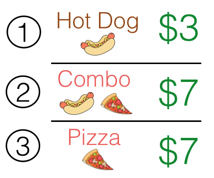Tricky Menus
 Sarah's restaurant's menu is seen above. About 70% of her customers order the hot dog, while 30% order the hot dog and pizza combo.
Sarah's restaurant's menu is seen above. About 70% of her customers order the hot dog, while 30% order the hot dog and pizza combo.
Allison's restaurant, which has very similar customers to Sarah's, adds a third option: pizza only for $7.

As expected, none of her customers choose this 3rd option, since it is strictly worse than the combo. However, 30% of her customers order the hot dog, while 70% of her customers order the combo -- the exact opposite of Sarah's customers!
When faced with effectively the same two menu choices, the customers preferences completely reversed. Is this possible in real life?
This section requires Javascript.
You are seeing this because something didn't load right. We suggest you, (a) try
refreshing the page, (b) enabling javascript if it is disabled on your browser and,
finally, (c)
loading the
non-javascript version of this page
. We're sorry about the hassle.
In Allison's restaurant, the fact that options 2 and 3 are the same price make it seem as though in option 2 you are getting the hot dog for free. People love the thought of getting something for free, even if (ironically) it ultimately involves spending more money to get the "free" item. So for those customers who like both hot dogs and pizza, it would be hard to resist getting a "deal" on the combo option. I can even imagine a couple of friends choosing Allison's restaurant over Sarah's and sharing the combo option because they think that they're getting better value. Great deception ... I mean marketing. :)